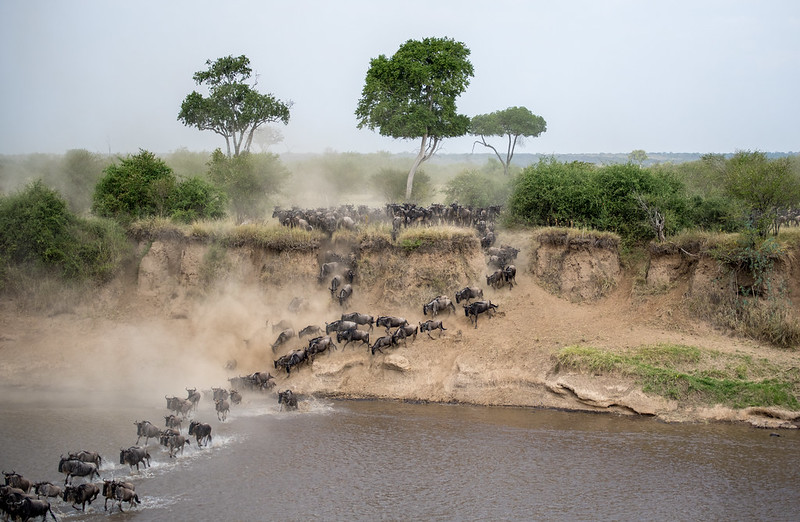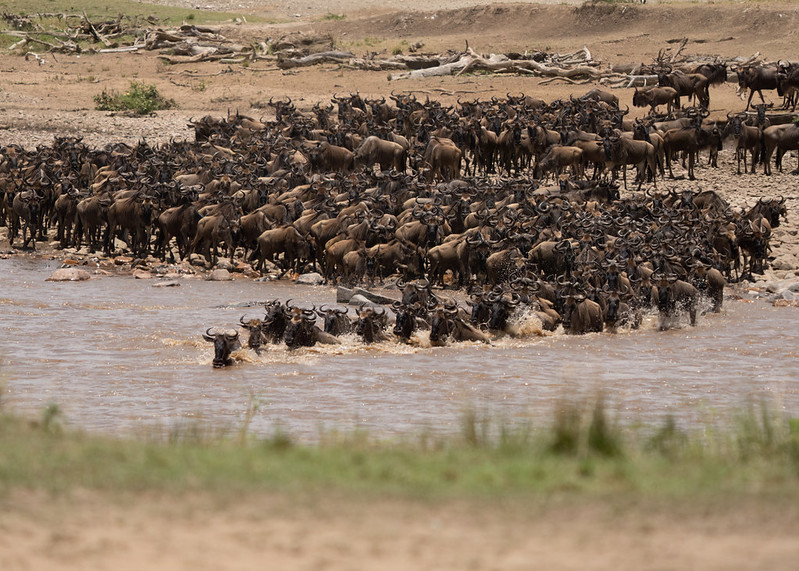Best places to see the wildebeest Migration
Best places to see the wildebeest Migration
Guide to Wildebeest Migration in Kenya and Tanzania safaris
Also referred to as the world cup football for animals or the greatest show in the world. The wildebeest involves mega heads of wildebeest followed by Zebras, elands, gazelles continuously travelling thousands of kilometers in clock wise direction from the Southern direction of Serengeti and crossing Northern direction through Mara River in to Masai mara in Kenya and back again.
The wildebeest Migration is one of Africa’s unique experiences which has drawn a huge number of visitors from various parts of the world to come and witness these Natural phenomena.
During the migration, the herds experience a full circle of life for mating, calving and death Amidists all the challenges encountered during the migration. Many animals often end being killed and eaten by the predators. Crossing the mara infested crocodile river as well as the big cats waiting along the shores of the river cause a threat to their survival. None the less, that’s is the cycle of life the big cats too their live are sustained by nature. Thus, jungle life is survival for the fittest.
Herds are constantly dividing and reuniting, going backwards before moving forward again, and experiencing various changes that might make the situation more chaotic than it might appear. Although the herds often follow the rains, the exact timing of their arrival at each location cannot be predicted. The exact site for a migration safari can be difficult to determine because the timing and routes change from year to year.
The best way to capture the Migration herds, is to stay in one of mobile safari camps, which are movable and the properties are moved each season following the migration routes, for full experience, you can spend two to three safari camps in different locations in the Serengeti or Masai mara depending on the schedule for your travel.
The Mara River crossing is the most dramatic sight and interesting spot for wildebeest viewing, but it’s recommended to plan your entire trip based on the wildebeest crossing since this experience is unpredictable and not guaranteed that you will be at the right place in the right time for the wildebeest Migration. Instead, consider river crossing as the bonus trip rather than the basing is as the sole reason to travel.
Where to see the Wildebeest Migration
Ngorongoro and Ndutu plains
Central Serengeti and the Western Corridor
Northern Serengeti and the Mara River
The Masai Mara
Eastern Serengeti
Best places for Migration Safari/ Where to see the Wildebeest Migration
Ngorongoro Conservation Area and Ndutu Plains
Ngorongoro Conservation situated south of the Serengeti National Park which also boarders the Ndutu plains in the Ngorongoro conservation area.
Ngorongoro Conservation Area and Ndutu Plains are two of the most famous wildlife destinations in Tanzania, located in the northern part of the country. Both areas are renowned for their stunning landscapes and abundant wildlife, making them popular attractions for tourists and nature enthusiasts.
Ngorongoro Conservation Area:
The Ngorongoro Conservation Area is a UNESCO World Heritage Site and a unique protected area in Tanzania. It was established in 1959 and spans over 8,000 square kilometers (3,100 square miles) of diverse landscapes, including grasslands, forests, and volcanic highlands. The most prominent feature of the area is the Ngorongoro Crater, which is the world’s largest inactive, intact, and unfilled volcanic caldera.
Key highlights of Ngorongoro Conservation Area:
Ngorongoro Crater: The caldera is approximately 20 kilometers (12 miles) in diameter and houses a remarkable ecosystem with a high concentration of wildlife. It is often referred to as the “Garden of Eden” due to its lush vegetation and rich animal populations.
Wildlife: The Ngorongoro Crater is home to a wide variety of wildlife, including the “Big Five” (lion, elephant, buffalo, leopard, and rhinoceros), wildebeest, zebras, hyenas, hippos, and various bird species.
Olduvai Gorge: Located within the conservation area, Olduvai Gorge is an important archaeological site where significant hominid fossils and stone tools were discovered, contributing to our understanding of human evolution.
Ndutu Plains:
Ndutu Plains, situated in the southeastern part of the Serengeti ecosystem, is an extension of the Ngorongoro Conservation Area. The area is characterized by vast grasslands and seasonal soda lakes, making it an essential part of the Great Migration route. The Great Migration is a spectacular natural event where millions of wildebeest, zebras, and other herbivores move in search of fresh grazing and water.
Key highlights of Ndutu Plains:
Great Migration which occurs during the months of December to March, the Ndutu Plains become the stage for the calving season of the wildebeest. This is an extraordinary time to witness the circle of life as baby wildebeests are born and face the challenges of survival amidst predators.
Predators: Ndutu Plains offer excellent opportunities for wildlife viewing, including predators like lions, cheetahs, and hyenas, which are attracted to the area due to the abundance of prey during the migration.
Both the Ngorongoro Conservation Area and Ndutu Plains are part of the larger Serengeti ecosystem, and together, they provide visitors with an unforgettable safari experience and a chance to witness the wonders of the African wildlife in their natural habitat. It’s important to note that these areas are strictly protected, and tourism is regulated to ensure the conservation of the delicate ecosystems and wildlife populations. Central Serengeti and the Western Corridor are two prominent regions located within the Serengeti National Park in Tanzania. The Serengeti is one of Africa’s most famous and iconic wildlife reserves, known for its incredible biodiversity and spectacular wildlife migrations.
Central Serengeti and the Western Corridor
Central Serengeti is often considered the heart of the Serengeti National Park. It is located in the southern part of the park and is characterized by vast open plains, scattered acacia trees, and rocky outcrops, known as kopjes. The region is famous for its year-round wildlife viewing opportunities, making it a prime destination for safari enthusiasts.
Key highlights of Central Serengeti include:
Central Serengeti is renowned for its high density of predators, particularly lions, leopards, and cheetahs. These predators thrive in the area due to the abundant prey species such as wildebeest, zebras, and gazelles.
Wildebeest Migration: Although the Great Migration is a continuous cycle of movement, during the dry season (June to October), large herds of wildebeest and zebras can be found in the Central Serengeti, as they gather to graze on the rich grasslands. At the heart of the park where you will find the Seronera river, the
This river flows through the region and is a vital water source for wildlife. It is a great spot for observing animals, especially during the dry season when many congregate around the riverbanks.
Western Corridor:
The Western Corridor is located in the western part of the Serengeti National Park, extending into the Grumeti Game Reserve. This region is characterized by riverine forests, open plains, and extensive grasslands. It is a significant part of the annual wildebeest migration route and offers excellent opportunities for wildlife viewing.
Key highlights of the Western Corridor include:
River Crossings: During the Great Migration (around May to July), large herds of wildebeest and zebras must cross the Grumeti River, which runs through the Western Corridor. These river crossings are breathtaking spectacles but are also fraught with danger due to lurking crocodiles and other predators.
The Grumeti River serves as a vital water source for the wildlife in the area. It attracts various species of animals, making it an exciting location for safari-goers.
Diverse Wildlife: In addition to the migrating herds, the Western Corridor is home to an array of other wildlife, including elephants, buffalo, giraffes, hippos, and a variety of bird species.
Both Central Serengeti and the Western Corridor offer unique safari experiences, and each has its own advantages depending on the time of year and specific wildlife sightings you wish to encounter. The Serengeti as a whole is a remarkable destination for wildlife enthusiasts, providing unforgettable encounters with Africa’s iconic animals in their natural habitat.
Northern Serengeti and the Masai River
The herds continue north through the Ikorongo Game Reserve en route to the Kogatende and Lamai areas, on the banks of the Mara River though they are still dispersed but you can see some small herds making their way to Mara river.


